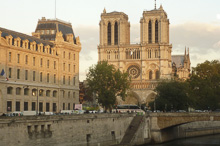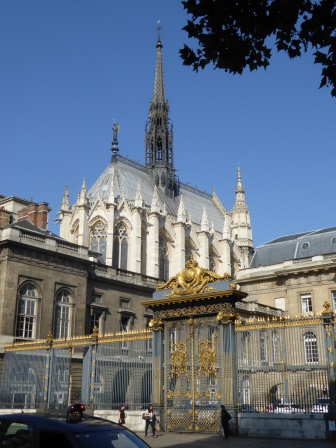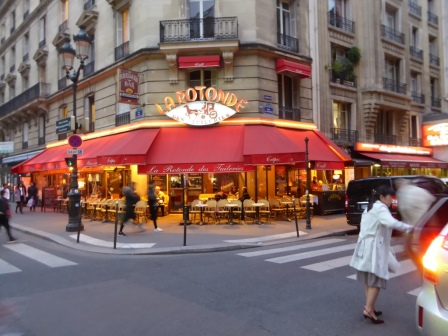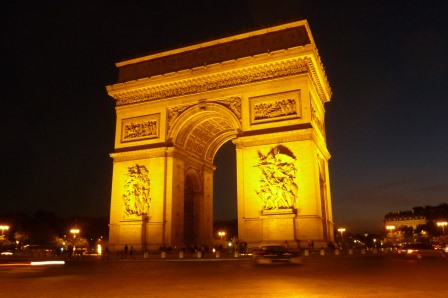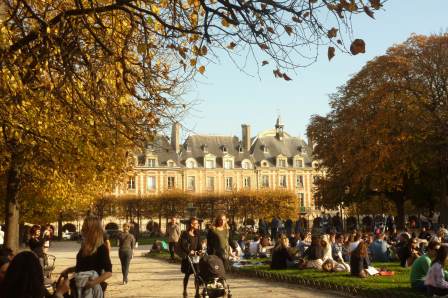Exploring Paris
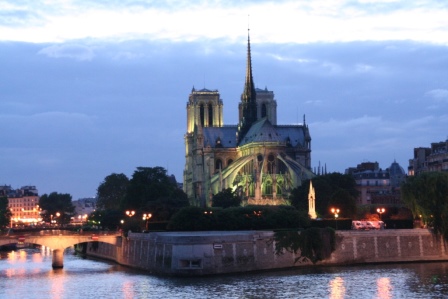 For us, the thrill of exploring Paris never diminishes, even with the easy familiarity of many regular visits over three decades. We agree wholeheartedly with this quote from another keen traveller:
For us, the thrill of exploring Paris never diminishes, even with the easy familiarity of many regular visits over three decades. We agree wholeheartedly with this quote from another keen traveller:
“To my mind, the greatest reward and luxury of travel is to be able to experience everyday things as if for the first time, to be in a position in which almost nothing is so familiar it is taken for granted.”
(Bill Bryson, BeMuse magazine, Jan-Mar. edition 2011)
Here are some of our favourite places and things to do in the City of Light.
Click the + to expand ⇓
The Cathedral celebrated its 850th anniversary in 2013, with many special events held throughout the year. The interior is sublime. If you’re there on a Sunday try and go to a service, at least for a while, to experience the whole atmosphere, but especially at a time when the organ is being played. The great Rose window is breathtaking.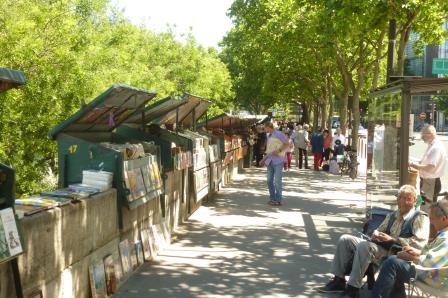
There is a lovely flower market on the Ile de la Cité at Place Louis Lepine which operates Monday to Saturday. It displays rows of cut flowers, potted plants and pots for plants, seeds and supplies for those thousands of window boxes hanging from the windows of many apartment buildings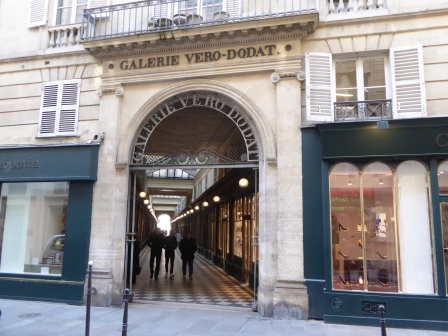
Also on the island, right at the end off the Square de L’Ile de France, facing the Ile St Louis is a small, very moving monument called Memorial de la Deportation, commemorating those deported from France during the Holocaust.
Once the Chapel Royal, now surrounded by the buildings comprising the Palais de Justice, this breathtaking Gothic jewel from the 13th century is constructed almost entirely from exquisite stained glass. 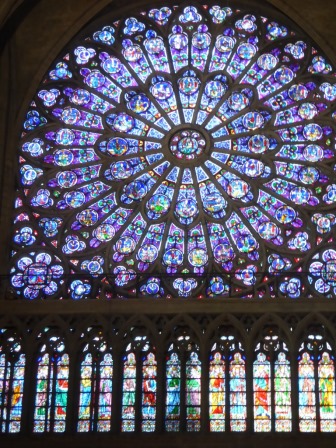 Chamber music concerts are held there regularly and are usually quite inexpensive.
Chamber music concerts are held there regularly and are usually quite inexpensive.
The Bouquinistes of Paris
The Quais along both sides of the Seine in the vicinity of Notre Dame, and especially the Left Bank, are lined with stallholders selling old prints, posters, magazines, antiquarian books etc. Quai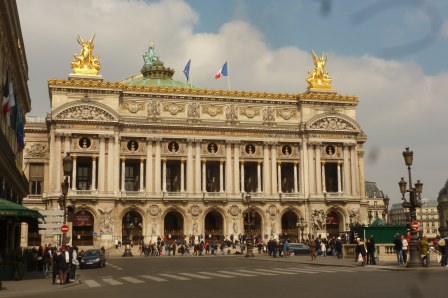 Montebello is particularly good as a viewing place for Notre Dame, even more so at night when it is beautifully floodlit. The spot-lights on the river cruise-boats add an eerie glow to the cathedral as they glide by.
Montebello is particularly good as a viewing place for Notre Dame, even more so at night when it is beautifully floodlit. The spot-lights on the river cruise-boats add an eerie glow to the cathedral as they glide by.
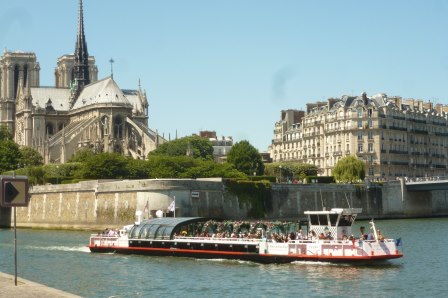 From late July until mid August the banks of the Seine are transformed into a city beach known as Paris Plage. Tonnes of sand, beach umbrellas and furniture, portable bars and
From late July until mid August the banks of the Seine are transformed into a city beach known as Paris Plage. Tonnes of sand, beach umbrellas and furniture, portable bars and 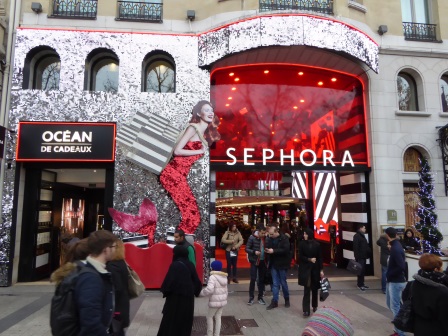 ice-cream sellers entertain all those who cannot escape to a “real” beach resort.
ice-cream sellers entertain all those who cannot escape to a “real” beach resort.
The other island in the Seine is Ile St Louis, which still has its medieval street pattern. A number of restaurants and small shops, such as l’Occitane, are located along its main street.
O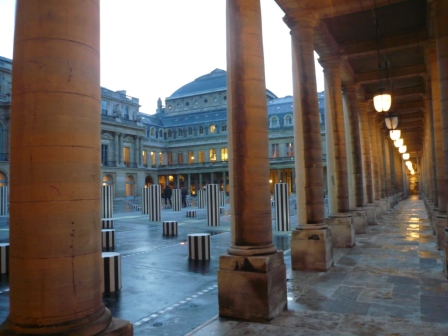 liviers & Co. sells every possible product derived from olives, including the wonderful olive oil soaps. The whole island is unlike anywhere else in Paris.
liviers & Co. sells every possible product derived from olives, including the wonderful olive oil soaps. The whole island is unlike anywhere else in Paris.
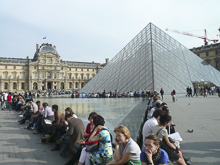 Louvre Museum and Jardin des Tuileries
Louvre Museum and Jardin des Tuileries
The Louvre Museum is one of the world’s greatest. Whatever your preferences in art, there’s a vast collection devoted to it. Naturally, the “headline” exhibits include the Mona Lisa, the Winged Victory of Samothrace and the Venus de Milo, but there’s a wonderful collection of Roman and Greek sculpture and more Leonardos than you ever dreamt existed. There always seems to be special exhibitions, so it’s worthwhile checking street posters, or go down the escalator to the main entrance and investigate. www.louvre.fr/en
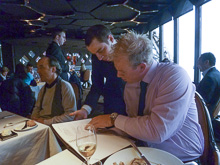 Aside from its vast collections, it has an enormous underground area, extending under the Tuileries, with vast shopping arcades. The Louvre Gallery Shops have wonderful collections of art, history of art, architecture and related books as well as excellent reproduction posters, greeting cards, and great souvenirs based on famous exhibits. A fantastic shop that solves all gift-buying needs under one roof.
Aside from its vast collections, it has an enormous underground area, extending under the Tuileries, with vast shopping arcades. The Louvre Gallery Shops have wonderful collections of art, history of art, architecture and related books as well as excellent reproduction posters, greeting cards, and great souvenirs based on famous exhibits. A fantastic shop that solves all gift-buying needs under one roof.
The Jardin des Tuileries in front of the Louvre are a lovely way to take a break from being a tourist. There’s a large pond where children sail model boats, and plenty of benches to sit and have a rest or a baguette for lunch.
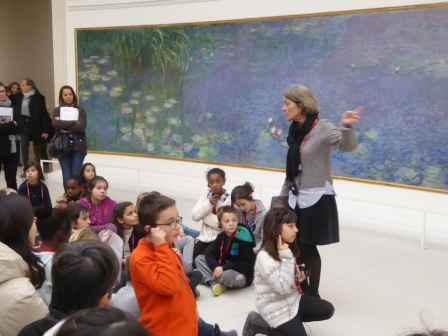 The Musée de l’Orangerie. This is one of the two Classical buildings at the end of the Tuileries facing onto Place de la Concorde. Its most famous collection is Monet’s Nymphéas (waterlilies) series, but also has works by artists such as Renoir, Modigliani, Rousseau, Cezanne, and Utrillo amongst others. www.musee-orangerie.fr
The Musée de l’Orangerie. This is one of the two Classical buildings at the end of the Tuileries facing onto Place de la Concorde. Its most famous collection is Monet’s Nymphéas (waterlilies) series, but also has works by artists such as Renoir, Modigliani, Rousseau, Cezanne, and Utrillo amongst others. www.musee-orangerie.fr
The greatest Parisian boulevard, the Champs Élysées stretches from Place de la Concorde to the Arc de Triomphe. It is lined with numerous cafes including the historic Fouquets, the House of Guerlain perfumer-maker, and the cosmetics emporium, Sephora. At the Place de la Concorde  end at certain times of year such as Christmas, you might be lucky enough to see the enormous Ferris wheel called La Grande Roue—the best views of the City are from its top. During the Christmas season, the Champs Élysées comes alive with its famous Christmas Markets and spectacular decorative street lighting.
end at certain times of year such as Christmas, you might be lucky enough to see the enormous Ferris wheel called La Grande Roue—the best views of the City are from its top. During the Christmas season, the Champs Élysées comes alive with its famous Christmas Markets and spectacular decorative street lighting.
The “old” Opéra Garnier at Place de l’Opéra is now kept mostly for ballet. Opera performances and concerts have generally moved to the “new” Opera house at the Bastille. The auditorium’s ceiling is by Marc Chagall, while the incredible foyers are worth visiting in their own right. There is also a museum devoted to opera history featuring set models, photographs and paintings. Both Opera Garnier and Opera Bastille’s programmes can be viewed, and tickets booked online at www.operadeparis.fr
Behind the Opera in bvd Haussmann you will find the two most famous Parisian department stores, Galeries Lafayette and Printemps.
Off the Rue de Rivoli, up Place du Palais Royal, this is a part of Paris often missed by visitors. Walk through to a lovely quiet square called “le Jardin du Palais Royal,” where you’ll find seats around a rose garden. Nowadays you will find many elegant boutiques amongst the old-fashioned dealers in stamps, lead model soldiers etc.
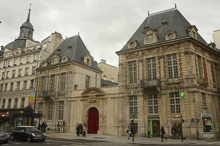 The Marais is certainly one of Paris’ most interesting and unique areas—a real gem, not to be missed. It comprises the 4th arrondissement, but also “stretches” up to parts of the 3rd. The whole area was the subject of one of Europe’s greatest urban renewal programs where derelict once-grand townhouses (‘hôtels particuliers’) and old shops have been restored, renovated or generally rehabilitated. A veritable treasure-trove of culture, cafes, galleries and shopping!
The Marais is certainly one of Paris’ most interesting and unique areas—a real gem, not to be missed. It comprises the 4th arrondissement, but also “stretches” up to parts of the 3rd. The whole area was the subject of one of Europe’s greatest urban renewal programs where derelict once-grand townhouses (‘hôtels particuliers’) and old shops have been restored, renovated or generally rehabilitated. A veritable treasure-trove of culture, cafes, galleries and shopping!
The Place des Vosges is generally agreed to be the most beautiful square in Paris. Its surrounding buildings are constructed from red brick and stone, with a deep arcade going all the way around, and in the centre is a popular park and children’s playground. The shops under the covered colonnade around the square consist of a myriad of small 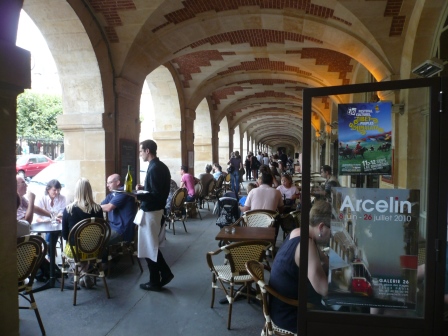 art galleries and a few elegant boutiques. A couple of cosy cafes are perfect for people-watching, particularly on Sunday afternoons, which is a popular Paris tradition. The intimate and inviting scale and overall charm of the Place des Vosges will draw you back on every visit to Paris.
art galleries and a few elegant boutiques. A couple of cosy cafes are perfect for people-watching, particularly on Sunday afternoons, which is a popular Paris tradition. The intimate and inviting scale and overall charm of the Place des Vosges will draw you back on every visit to Paris.
Maison Victor Hugo is at no. 6 Place des Vosges, which, as well as being a museum, is an important research centre, including a library. The Museum shop is a gold mine for things relating to the great man, as well as his literature. Open daily except Mondays and holidays, with free admission to the permanent collections.
The streets surrounding Place des Vosges, rue Des Francs-Bourgeois in particular, are shoppers’ and browsers’ heaven—lots of small, individual boutiques, cafes, homewares and “collectibles”. Sequoia at no. 6 has some of the most stylish, fun bags in Paris, made from Prada-like nylon, in a range of bright, happy colours—they also have a branch at 72 bis, rue Bonaparte in the 6th arrond. Bensimon at no. 8 has a good collection of modern homewares that have clean lines, are functional and inexpensive. Argenterie des Francs-Bourgeois at no. 17 sells antique and specialty silverware by weight. For vintage posters, prints, cards, go to A l’Image du Grenier Sur l’Eau at no. 45. For terrific womenswear, have a look at Abou d’abi Bazar at no. 10—affordable, young hot-shot designers whose creations are organised by colour, plus brilliant accessories; Plein Sud at no. 21 has dead-sexy dresses—a bit of a splurge, but great clothes with wardrobe longevity.
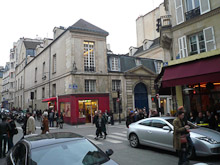 Caravane at 6 rue Pavée, which runs off rue des francs-Bourgeois, opposite Musée Carnavalet, has fabulous hand-made quilts from Bengal, cotton and organdie tunics, travel accessories etc. OK, so the merchandise isn’t French, but it’s to-die-for, and you’ll want to move in.
Caravane at 6 rue Pavée, which runs off rue des francs-Bourgeois, opposite Musée Carnavalet, has fabulous hand-made quilts from Bengal, cotton and organdie tunics, travel accessories etc. OK, so the merchandise isn’t French, but it’s to-die-for, and you’ll want to move in.
Crea Concept, 2 bis, rue des Rosiers, just off rue Pavée, is one of the most innovative womenswear boutiques in the city. The styling is very modern, with a somewhat asymmetric cut reminiscent of the edgier Japanese designers, and miraculously, has a size range from Small to X-Large—these designs are the antithesis of the short, tight, tailored suit traditionalists.
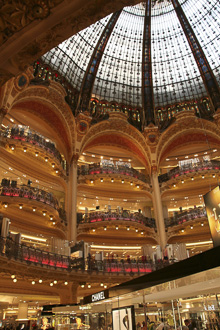 Another great fashion shop is COS, next door to Crea, at no. 2 rue des Rosiers. Inexpensive, good quality, creative designs for women, men and children. There are other two other branches in Paris, but this one is a particular favourite. Note though that this store is open Monday-Saturdays, closed Sundays.
Another great fashion shop is COS, next door to Crea, at no. 2 rue des Rosiers. Inexpensive, good quality, creative designs for women, men and children. There are other two other branches in Paris, but this one is a particular favourite. Note though that this store is open Monday-Saturdays, closed Sundays.
Also in rue des Rosiers at no. 14 is Cecile et Jeanne, one of our favourite costume jewellery and accessory shops (esp. delicious handbags). Well-priced, distinctive designs. They have another shop at 12 rue Francs-Bourgeois, as well as the Carrousel du Louvre, their own counters in Galeries Lafayette, Au Printemps and Bon Marché, plus both Charles de Gaulle and Orly airports. Terrific goodies!
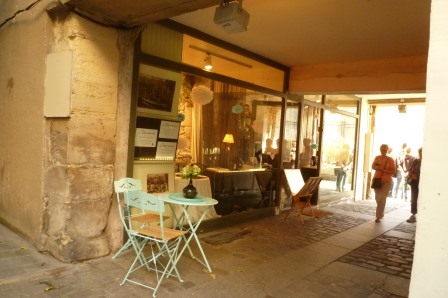 The Marais has some of the best, most individual and (mostly) affordable menswear in Paris. For example, have a look at Loft, 12 rue de Sévigné. This shop also has a branch at 12 rue du Faubourg St Honoré (very out of place, price-wise, in this street!). Lots of other interesting, individual menswear shops along rue Ste-Croix-de-la-Bretonnerie, such as Boy’z-Bazaar at no. 5.
The Marais has some of the best, most individual and (mostly) affordable menswear in Paris. For example, have a look at Loft, 12 rue de Sévigné. This shop also has a branch at 12 rue du Faubourg St Honoré (very out of place, price-wise, in this street!). Lots of other interesting, individual menswear shops along rue Ste-Croix-de-la-Bretonnerie, such as Boy’z-Bazaar at no. 5.
La Belle Hortense, 31 rue Vieille-du-Temple is no ordinary wine bar—it’s an elegant space in a wonderful stone-walled, timber-panelled “library”, lots of pictures and photographs, but what makes it so special is that it is combined with a plethora of books on poetry, history, philosophy and other works of literature under the one roof! What more could a weary tourist need to refresh body and mind!
Sentou Galerie, at 18 and 24 rue Pont Louis-Philippe, is favoured by interior decor magazines such as Marie Claire Maison, for trend-setting modern tableware, accessories and furnishings. Located a few streets behind the Hôtel de Ville.
In the rue du Pont Louis-Philippe at no. 12, is Monastica, which sells beautiful soaps, honey, linens and pottery found in monasteries. This street runs off the bridge of the same name, at the tip of the Ile St. Louis, facing the back-end of Notre-Dame.
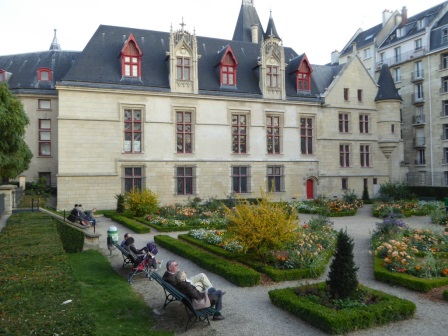 One shop that deserves a mention here is L’Eclaireur at 40 rue de Sévigné which runs alongside the Musée Carnavalet, in the 3rd arr. The edgy, high quality fashion is almost secondary to the an amazing fit-out, or more properly, an art installation featuring a wall of 147 animated video screens and something called the Surface table by Microsoft, which is a constantly-evolving installation projected onto a screen. They’ve got branches elsewhere, notably 12 rue Malher nearby in the 4th which is menswear featuring established and sought-after contemporary designers plus accessories. If fashion’s your passion, a visit to L’Eclaireur is a must. If interior décor is your thing, while in rue de Sévigné, have a look at Le Monde Sauvage at no. 21 for elegant, stylish and “baroque” accessories and curtains to match every kind of décor.
One shop that deserves a mention here is L’Eclaireur at 40 rue de Sévigné which runs alongside the Musée Carnavalet, in the 3rd arr. The edgy, high quality fashion is almost secondary to the an amazing fit-out, or more properly, an art installation featuring a wall of 147 animated video screens and something called the Surface table by Microsoft, which is a constantly-evolving installation projected onto a screen. They’ve got branches elsewhere, notably 12 rue Malher nearby in the 4th which is menswear featuring established and sought-after contemporary designers plus accessories. If fashion’s your passion, a visit to L’Eclaireur is a must. If interior décor is your thing, while in rue de Sévigné, have a look at Le Monde Sauvage at no. 21 for elegant, stylish and “baroque” accessories and curtains to match every kind of décor.
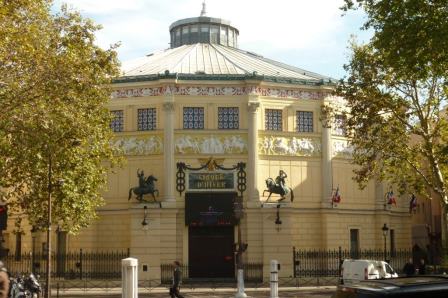 Most visitors to Paris know about the Marais district, which is, broadly speaking, the 4th arrondissement. However, a lesser-known area is the 3rd arrondissement, which morphs into the 4th. The 3rd is the second-smallest in area of the 20 arrondissements of Paris and comprises the northern part of the medieval Marais, and referred to nowadays as the Haut (Upper) Marais. It is difficult to tell where the boundaries are of these districts, and indeed one side of a street may in one arrondissement but the other side is in the other. The 3rd is fast becoming the preferred location for small galleries, up-and-coming fashion designers and their ateliers as well as a wide variety of interesting cafes and restaurants. As a result, it is now a highly desirable place to live with apartments now fetching some of the highest prices in Paris.
Most visitors to Paris know about the Marais district, which is, broadly speaking, the 4th arrondissement. However, a lesser-known area is the 3rd arrondissement, which morphs into the 4th. The 3rd is the second-smallest in area of the 20 arrondissements of Paris and comprises the northern part of the medieval Marais, and referred to nowadays as the Haut (Upper) Marais. It is difficult to tell where the boundaries are of these districts, and indeed one side of a street may in one arrondissement but the other side is in the other. The 3rd is fast becoming the preferred location for small galleries, up-and-coming fashion designers and their ateliers as well as a wide variety of interesting cafes and restaurants. As a result, it is now a highly desirable place to live with apartments now fetching some of the highest prices in Paris.
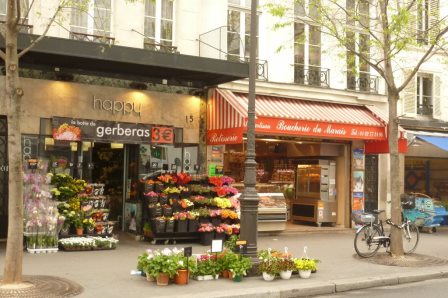 As with so many areas of the city, food plays a very prominent role in the life of the 3rd particularly along the rue de Bretagne. There is a great selection of wonderful food shops featuring a wide range of fresh produce available daily. Les Enfants Rouges covered market, at 39 rue de Bretagne, is an historic landmark. Dating from 1612, it is not only the oldest covered market in Paris, but according to the Paris Tourist Office, it is the oldest in Europe.
As with so many areas of the city, food plays a very prominent role in the life of the 3rd particularly along the rue de Bretagne. There is a great selection of wonderful food shops featuring a wide range of fresh produce available daily. Les Enfants Rouges covered market, at 39 rue de Bretagne, is an historic landmark. Dating from 1612, it is not only the oldest covered market in Paris, but according to the Paris Tourist Office, it is the oldest in Europe.
One of the best-loved restaurants in the neighbourhood is Chez Omar at 47 rue de Bretagne which has some of the best North African cuisine in the city. Chef Alain Carrère offers a good value prix fixe option at his well-regarded restaurant Le Pamphlet at 38 rue Debelleyme—and just around the corner is his other restaurant, Le Petit Pamphlet.
However, it’s not only about food in the 3rd. Over the last few years, the area has become known for its individual fashion boutiques, and lately a number of well-known French clothing stores, such as Comptoir des Cottoniers, who specialise in beautiful quality cotton knits, at 124 rue Vieille du Temple. Avant-garde Korean designer Moon Young Hee at 62 rue Charlot is known for her deconstructionist designs in beautiful fabrics, while the elegant Hoses at 41 rue de Poitou is the place to go for designer handbags, jewellery and other accessories, as well as being a showcase for established and up-and-coming fashion labels.
The much sought-after designs of Isabel Marant can be found in her boutique at 47 rue Staintonge. At no. 29 rue Charlot you will find Pring, the Paris-based Thai-American designer who designs her own range of over-the-top shoes and accessories made from exotic materials such as water snake skin, glazed calfskin or metallic velvet.
Lately, a few international fashion labels have started to creep into the Upper Marais such as the very stylish German womenswear company, Oska, at 133 rue Vieille du Temple. This well-made designer label carries a very good size range, so well worth seeking out.
One of the hottest destinations in Paris is Boutique Merci, at 111 Bvd. Beaumarchais, very close to metro St Sebastien Froissart just off rue de Bretagne. This is a charity shop with a difference, more accurately a “concept” shop stocking highly desirable designer labels and jewellery pieces, vintage fashion, homewares in clever decorating spaces, plus a great little café.
Take some time to explore the restored historic Hotel de Retz and the Passage de Retz at 9 rue Charlot. Built in 1613, it is now home to changing art exhibition spaces, a bookshop and café.
These are just some of the interesting boutiques, restaurants, galleries and other interesting places to be discovered in the Haut Marais
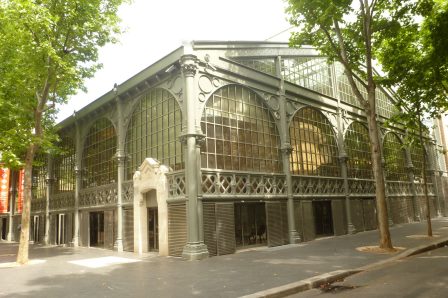 The Haut Marais has one of the most fascinating histories of any part of Paris. The military Order of the Knights Templars settled in the area in 1139, turned their vast land holding into the city’s market garden (marais), and then constructed their enormous fortress which served as their European headquarters. This was complete with watch towers and a drawbridge that led to the Temple’s only gate (now the corner of rue des Fontaines-du-Temple and rue du Temple). Rue de Picardie, rue du Temple, rue de Bretagne and rue Beranger are all that remain of the Enclos du Temple.
The Haut Marais has one of the most fascinating histories of any part of Paris. The military Order of the Knights Templars settled in the area in 1139, turned their vast land holding into the city’s market garden (marais), and then constructed their enormous fortress which served as their European headquarters. This was complete with watch towers and a drawbridge that led to the Temple’s only gate (now the corner of rue des Fontaines-du-Temple and rue du Temple). Rue de Picardie, rue du Temple, rue de Bretagne and rue Beranger are all that remain of the Enclos du Temple.
The French branch of the Order was disbanded in 1313, their vast wealth seized by the Crown and handed over to the rival Order of Hospitallers, who occupied the Enclos until the French Revolution. The Order was disbanded by Napoleon III in the early 19th century. The palace of the Grand Prieur of the Order, which occupied a site on what is now the corner of rue de Bretagne and rue du Temple, became a residence for the illegitimate sons of royalty. During the reign of Louis XVI, the Grand Prieur was the king’s brother, the infamous Prince de Condé, who lorded over an alternative court of his own. The ten year old Mozart played for the Prince and his guests at a glittering soirée at the palace, an event commemorated in a painting by Michel Barthélémy Ollivier entitled ‘Mozart Giving a Concert in the ‘Salon des Quatre-glaces au Palais du Temple’ dated 1773.
During the Revolution the King was held in the Temple, and was taken from there on a tumbrel on 21 January 1793 to his execution at Place de la Révolution (now Place de la Concorde). The Temple became in turns a military barracks, the Ministry of Religion under Napoleon I, a convent during the restoration and finally demolished by Baron Haussmann under Napoleon III in 1853.
The nearby Place de la Republique marks the alignment of the ancient defensive wall around Paris built by Charles V in the 14th century, at the same time as the new fortress of the Bastille was constructed to control the city’s restless population.
The Marais as a whole became the preferred neighbourhood for grand private town houses (hôtels particuliers) of the aristocracy that today are treasured for their historic and architectural importance. One such is the magnificent Musée Carnavalet at no.23 rue de Sévigné, dedicated to the history of the city. Another is the Hôtel de Guénégaud at 60 rue des Archives, now the Club and Musée de la Chasse et de la Nature. One of the finest hôtels particuliers of the Marais is the Hôtel Salé in rue de Thorigny, built in 1656 for a wealthy tax farmer and which later became the Embassy of the Venetian Republic in 1671, now houses the Musée Picasso.
The oldest surviving private house of Paris, built in 1407 by Nicolas Flamel, is to be found in the 3rd arrondissement, at no. 51 rue de Montmorency. Madame de Sévigné lived for a time in the same street at no. 8.
In 1969, France’s first Minister of Culture, Andre Malraux, made the Marais the first sector of Paris to be protected from adverse development. This legacy is now celebrated by Parisians and visitors alike in the vibrant, urban character of this distinctive part of Paris.
The Musée Carnavalet at 23 rue de Sévigné is situated in a pair of adjoining historic mansions. Dedicated to the history of the city of Paris, its fascinating collection comprises a huge quantity of paintings, engravings, ceramics, furniture and artefacts.
The wonderful Musée Picasso is located in rue Thorigny. Housed in a former grand private residence, the Hôtel Salé, the collection contains more than 3,000 works by Picasso ranging from drawings, paintings and sculptures. These are complemented by works from Picasso’s personal art collection by other artists such as Matisse, Cezanne, Seurat and Degas. Note that it is expected to re-open in late 2013, after a massive renovation programme.
One of the most interesting museums in Paris is the Musée des Arts et Métiers at 60 Rue Réaumur. Housed in the former abbey of St-Martin-des Champs, it is the collection of the Conservatoire National des Arts et Métiers (National Conservatory of Arts and Industry) imaginatively displaying a huge array of remarkable scientific instruments, drawings and artefacts such as Lavoisier’s gasometers, Corning optical fibres, the cinematograph device by the Lumière brothers, Watt’s steam engine, Volta’s first invention of the battery, as well as a Stephenson locomotive.
The Musée Cognacq-Jay, located in the 16th century Hôtel Donon at 8 rue Elzévir, has an exceptional collection of paintings, ceramics and other decorative objects mostly from the 18th century, including works by Fragonard, Boucher, Tiepolo and Watteau, but also a couple of Rembrandts, and later artists such as Cézanne, Degas and Corot. Note that this museum is free.
As well as museums and galleries displaying art and objects of the past, the 3rd arrondissement is an area well-known for its many contemporary galleries. One of the most innovative and interesting galleries is Galerie Duboys at 6 rue des Coutures Saint-Gervais, which is a small street running alongside the Picasso Museum. This great little gallery is part-owned and run by Mme Dominique Balle-Calix who speaks flawless English and loves to chat with visitors about the artists her gallery represents.
View the latest works of up-and-coming and established artists at the very chic Galerie Thaddaeus Ropac, 7 rue Debelleyme, who represents artists such as Tom Sachs and Gilbert & George. One of France’s most prominent galleries is Galerie Yvon Lambert at 108 rue Vielle du Temple shows works by Keiffer, Serrano and Le Witt amongst others. The small FAT Galerie at 1 rue Dupetit-Thouars is worth seeking out to see some of France’s leading and hippest artists and designers. Their exhibitions rotate regularly, and there is a small shop to tempt the visitor to take home a piece of handcrafted object d’art.
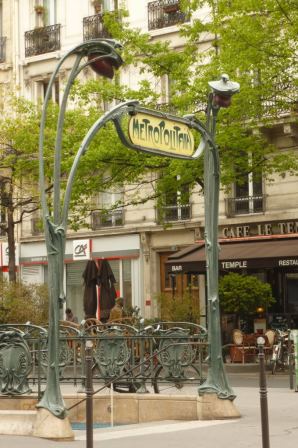 A few blocks on the other side of Place de la Republique marks the location on the Canal St Martin where the canal cruise boats emerge into the daylight from the tunnel which passes under Place de la Bastille. The Canal, bordered by beautiful chestnut trees, continues on under swing bridges and footbridges to its destination at Parc de la Villette. The canal trip can be taken in either direction, or simply enjoy a stroll along the tree-lined banks, as far as Place de Stalingrad. La Villette was once one of Paris’ livestock markets. Now a science and technology park, as well as a large stadium-style theatre, exhibition halls, and most recently, the new Paris Conservatoire—all well worth seeing. Metro Porte de la Villette.
A few blocks on the other side of Place de la Republique marks the location on the Canal St Martin where the canal cruise boats emerge into the daylight from the tunnel which passes under Place de la Bastille. The Canal, bordered by beautiful chestnut trees, continues on under swing bridges and footbridges to its destination at Parc de la Villette. The canal trip can be taken in either direction, or simply enjoy a stroll along the tree-lined banks, as far as Place de Stalingrad. La Villette was once one of Paris’ livestock markets. Now a science and technology park, as well as a large stadium-style theatre, exhibition halls, and most recently, the new Paris Conservatoire—all well worth seeing. Metro Porte de la Villette.
The area bordering the 3rd and the 11th arr. has the largest outdoor market in Paris, located along Bvd Richard Lenoir, starting at Place de la Bastille. Marché Richard Lenoir is held on Thursday and Sunday mornings, and is renowned for its spectacular seafood. As well, there are vendors selling a huge range of produce from their own secret-recipe terrines and pâtés, to others offering delicious, ready-prepared gourmet treats to take home and enjoy. From here, take a leisurely stroll up rue Oberkampf to metro Parmentier, passing along another of Paris’ famous food streets.
St Germain des Pres
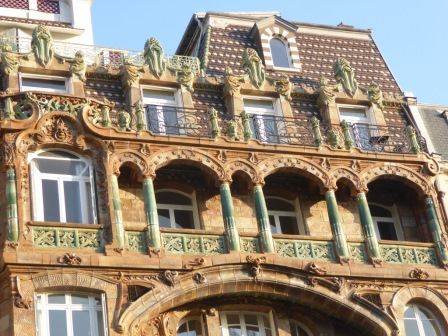 Around the Church of St Germain des Pres area (Le Deux Magots cafe is opposite), are streets to explore to discover the ‘real’ Paris, such as rue de Seine, which is home to dozens of small private galleries.
Around the Church of St Germain des Pres area (Le Deux Magots cafe is opposite), are streets to explore to discover the ‘real’ Paris, such as rue de Seine, which is home to dozens of small private galleries.
On the corner of rue de Seine and rue de Buci is one of Paris’ most famous street markets, Marché de Buci, in Paris (however, many Parisians say not The best). Mornings are best for visiting most markets. This one is very up-market—the flower and food displays are magnificent, and there are a number of fashionable cafes perfect for people-watching.
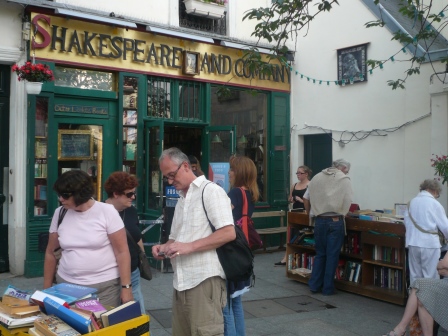 Taschen Publishers has their own retail shop at 2 rue de Buci. This prestige company produces beautiful books covering every aspect of design, art, photography and architecture, and in keeping with their high standards, have a signed installation by design guru Philippe Starck. This shop is a must for art and design book devotees.
Taschen Publishers has their own retail shop at 2 rue de Buci. This prestige company produces beautiful books covering every aspect of design, art, photography and architecture, and in keeping with their high standards, have a signed installation by design guru Philippe Starck. This shop is a must for art and design book devotees.
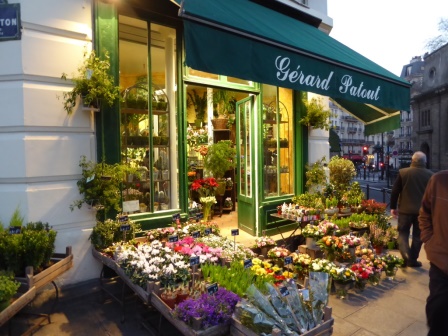 Rue du Bac, which runs off bvd St. Germain up to the bridge called the Pont Royal over the river, has a number of decorator shops, such as Blanc d’Ivoire at no. 104 that sells pottery, lovely quilts etc. Diners en
Rue du Bac, which runs off bvd St. Germain up to the bridge called the Pont Royal over the river, has a number of decorator shops, such as Blanc d’Ivoire at no. 104 that sells pottery, lovely quilts etc. Diners en 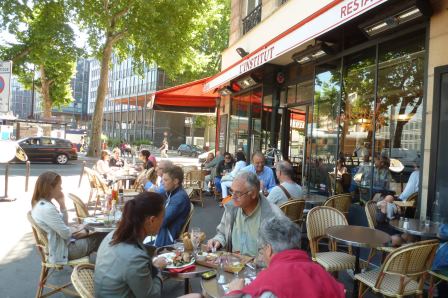 Ville at no. 89 has linens and decorative ceramics, Le Rideau de Paris at no. 32 has linens, lamps, frames and beautiful quilts, and Siecle at no. 24 has elegant little decorator “must haves.” A branch of the English homewares store, Conran Shop, is at no. 117. There are other Conran Shops in Paris such as at 30 bvd. des Capucines.
Ville at no. 89 has linens and decorative ceramics, Le Rideau de Paris at no. 32 has linens, lamps, frames and beautiful quilts, and Siecle at no. 24 has elegant little decorator “must haves.” A branch of the English homewares store, Conran Shop, is at no. 117. There are other Conran Shops in Paris such as at 30 bvd. des Capucines.
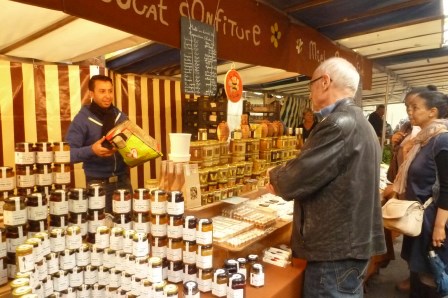 Rue Jacob is full of wonderful antique shops, as is rue Bonaparte—very classy, no bric-a-brac here! One boutique, Un Dimanche dans nos Campagnes, at no. 59 rue Bonaparte, has beautiful clothing, home and table accessories from the French provinces. Have a quick look at rue de Furstemberg, a tiny little pedestrianised “alley way” off rue Jacob, where you’ll find Musée Delacroix.
Rue Jacob is full of wonderful antique shops, as is rue Bonaparte—very classy, no bric-a-brac here! One boutique, Un Dimanche dans nos Campagnes, at no. 59 rue Bonaparte, has beautiful clothing, home and table accessories from the French provinces. Have a quick look at rue de Furstemberg, a tiny little pedestrianised “alley way” off rue Jacob, where you’ll find Musée Delacroix.
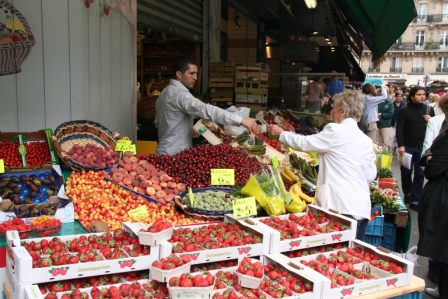 Also just nearby is Manuel Canovas at no. 6 rue de l’Abbaye, which is a small street running parallel to, and behind, the Church of St Germain des Pres, full of wonderful interior decor fabrics–absolutely divine and wickedly expensive. Canovas is considered one of Europe’s master print designers and colourists. A personal favourite however is Pierre Frey at no. 2 Place Furstemberg.
Also just nearby is Manuel Canovas at no. 6 rue de l’Abbaye, which is a small street running parallel to, and behind, the Church of St Germain des Pres, full of wonderful interior decor fabrics–absolutely divine and wickedly expensive. Canovas is considered one of Europe’s master print designers and colourists. A personal favourite however is Pierre Frey at no. 2 Place Furstemberg.
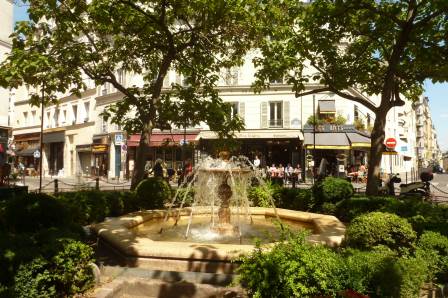 This whole area of the left bank has “designer heaven” shops everywhere, as well as places where the “real people” go. One of our favourite little streets, the rue du Dragon, runs between bvd St Germain and the intersection called “Carrefour de la Croix Rouge” where rue de Sevres, rue de Grenelle, rue du Four all meet.
This whole area of the left bank has “designer heaven” shops everywhere, as well as places where the “real people” go. One of our favourite little streets, the rue du Dragon, runs between bvd St Germain and the intersection called “Carrefour de la Croix Rouge” where rue de Sevres, rue de Grenelle, rue du Four all meet.
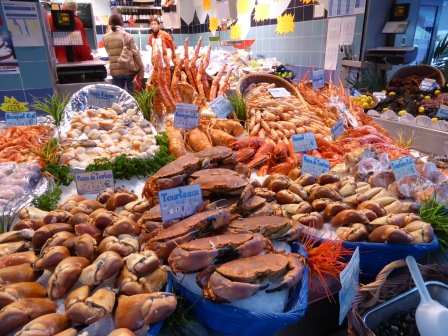 The rue du Dragon has one of our “Must Visit” shops. A small men’s and women’s shoe shop called Arche at no. 21, which sells the most divinely comfortable shoes ever created (a real treat for the feet!). Simple, minimalist styling in supple nubuck and calf leathers that somehow last forever. You’ll be hooked for life. There are numerous Arche shops in Paris, the biggest of which is in bvd de la Madeleine, more or less opposite Ste Marie Madeleine Church (generally referred to simply as La Madeleine). Most branches also sell men’s shoes. Even men who usually hate shopping, especially shoe-shopping, fall in love with Arche.
The rue du Dragon has one of our “Must Visit” shops. A small men’s and women’s shoe shop called Arche at no. 21, which sells the most divinely comfortable shoes ever created (a real treat for the feet!). Simple, minimalist styling in supple nubuck and calf leathers that somehow last forever. You’ll be hooked for life. There are numerous Arche shops in Paris, the biggest of which is in bvd de la Madeleine, more or less opposite Ste Marie Madeleine Church (generally referred to simply as La Madeleine). Most branches also sell men’s shoes. Even men who usually hate shopping, especially shoe-shopping, fall in love with Arche.
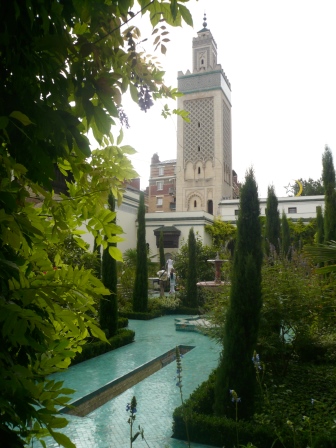 Another favourite is the (costume) jewellery of Agatha. There are Agatha shops in a couple of locations (including Galeries Lafayette, although this one is not great). There are good ones at Carousel du Louvre and at 97 rue de Rennes. Their motif/logo is the Scottie dog, and they have some great, fun pieces.
Another favourite is the (costume) jewellery of Agatha. There are Agatha shops in a couple of locations (including Galeries Lafayette, although this one is not great). There are good ones at Carousel du Louvre and at 97 rue de Rennes. Their motif/logo is the Scottie dog, and they have some great, fun pieces.
A great little shop you always try and visit is La Vaissellerie at 85 rue de Rennes (at least three other branches in Paris as well). This minute shop is absolutely crammed to overflowing with table and kitchenware, such as porcelain soup bowls, platters; pretty placemats and coasters, often with French café-theme scenes and motifs; cute pâté knives shaped like baguettes etc.—this is fun, bargain territory! There are numerous scattered throughout the city.
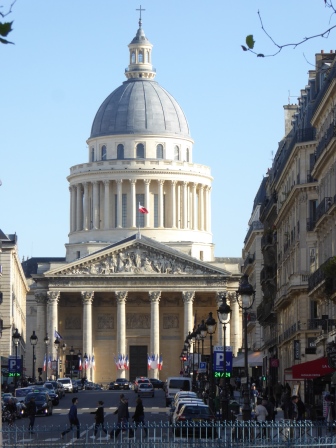 If you’re into the Provençal look, Souleiado at 78 rue de Seine is great. They’ve got all the traditional Provençal print fabrics, table napery, gifts, shawls and pareos, bags, etc.
If you’re into the Provençal look, Souleiado at 78 rue de Seine is great. They’ve got all the traditional Provençal print fabrics, table napery, gifts, shawls and pareos, bags, etc.
Not far away, tucked into a little street that runs off the Marché St Germain is one of those shops that should, if it isn’t already, be included in a book about “shopping secrets of Paris”. It is a so-called “dépôt de vente”, where well-heeled ladies take fashion they’ve tired of (‘second-hand’ seems too harsh a description!) or no longer fit into. Its name is Les Trois Marchés de Catherine B, at Nos. 1 & 3 rue Guisarde—this is between rue du Four and Place St Sulpice. 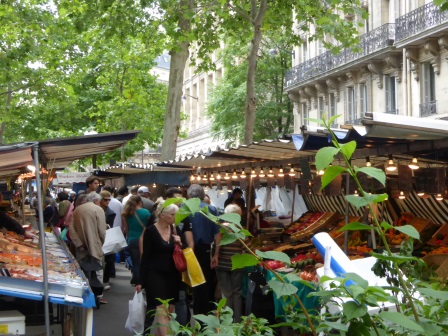 You’ll find pre-loved and vintage Chanel and Hermès fashion and accessories such as jewellery, scarves and bags (however, don’t ever expect to find the ultimate fantasy bags: either a red crocodile Birkin or a black croc Kelly bag with just the right patina of age!).
You’ll find pre-loved and vintage Chanel and Hermès fashion and accessories such as jewellery, scarves and bags (however, don’t ever expect to find the ultimate fantasy bags: either a red crocodile Birkin or a black croc Kelly bag with just the right patina of age!).
Contact Us
Paris Vacation Apartments
Weekly and Short Term Rentals
Email: mail@parisgourmandapartments.com
Ph/Fax: +61 2 9969 3164

